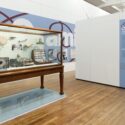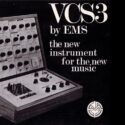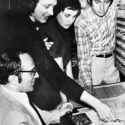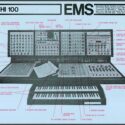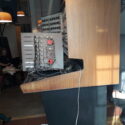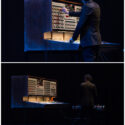From obsolete technology to performance instrument: new live presentations of the EMS Synthi 100
Article DOI: https://dx.doi.org/10.15180/231904
Abstract
The presentation of electronic musical instruments in museum and other institutional contexts prompts a number of questions about the restoration of sound technologies, the reconstruction of musical practices and techniques, and past and present cultures of electronic music, among other topics. Drawing from research into the electronic musical instrument company and sound studio EMS London Ltd, which produced synthesizers and other devices during the 1970s, this paper outlines some examples of how an EMS synthesizer, the Synthi 100, has been restored and re-presented by academic, broadcasting and arts institutions in the last decade. Devised for compositional use in electronic music studios, in recent years the Synthi 100 has been used in concerts and broadcast media as an instrument for live performance. Focusing on some of these events, I ask how live performance is used to draw connections between electronic music’s past and present, as well as to attract new participants and audiences to concerts, exhibitions and broadcasts of electronic music.
Keywords
electronic music, EMS London Ltd, live music performance, musical instruments, restoration, sonic art, sound technology
Introduction
https://dx.doi.org/10.15180/Histories of electronic music are frequently narrated and presented to the public through the display of electronic musical instruments in museums of science and technology, such as the Science Museum, London, and the Norwegian Museum of Science, Technology and Medicine in Oslo, as well as museum collections of musical instruments, such as the Musical Instrument Museum in Brussels. Temporary exhibitions about electronic music and sound, such as the recent exhibitions Electronic: From Kraftwerk to The Chemical Brothers at London’s Design Museum (2020), and Sonic: Adventures in Audio at the Museum of Science and Media in Bradford (2021), include electronic musical instruments among the objects on display. In 2011, the Science Museum’s exhibition, From Oramics to Electronica: Revealing Histories of Electronic Music, took Daphne Oram’s Oramics Machine, then recently acquired by the Museum, as a starting point for a project that, through the Museum’s public history programme and a range of participatory projects, aimed to ‘gain better knowledge of how different audiences understand and interpret the history of a specific subject, in this case the history of electronic music’ (Boon et al, 2014).
Restored electronic musical instruments can also be used to engage the public in electronic music histories in settings outside of museums, including educational institutions, media platforms and live music and arts venues. This is particularly the case when instruments are used in the research and promotion of histories of specific electronic music institutions. This paper gives an account of some recent public-facing projects concerning a synthesizer built in the 1970s, the EMS Synthi 100. In these projects, Synthi 100s have been restored, not for museum display, but in order that composers and artists can create new works for public performance, as part of larger projects connected to the histories of electronic music institutions. I have used the term ‘public-facing’ not only to denote a degree of public display and/or performance, but also to distinguish these projects, which are made possible with varying degrees of institutional or governmental support, from private or commercial instrument restoration projects, while acknowledging that these different kinds of projects sometimes overlap and certainly inform one another.
Public-facing projects of restoration and performance involving Synthi 100s have so far been carried out at educational and broadcasting institutions in Greece, Serbia, Belgium, Australia and Spain. In this paper I provide accounts of some of these projects, focusing on those carried out at Radio Belgrade 3 and at the Contemporary Music Research Centre (KYSME-CMRC) in Athens, and describe the networks of knowledge and practice that facilitate such projects. In discussing two concert performances that use restored Synthi 100s, I consider, using an approach informed by STS, how such institutions make use of the Synthi 100 as a performance instrument in the framing and celebration of their histories, and the wider history of electronic music in national and international settings. In the following section I introduce the Synthi 100 and the company that made it, EMS London Ltd, tracing its journey from innovative studio device to obsolete technology, ending with its current status as a valuable historic instrument.
EMS London Ltd and the Synthi 100 synthesizer
EMS (Electronic Music Studios) was a sound studio and electronic instrument company founded in London in the late 1960s by the technologist and composer Peter Zinovieff. EMS occupies an important place in the history of music and computing, as one of the earliest centres of computer-controlled composition in the world. As an instrument manufacturer, EMS is best known for its VCS3, a small portable analogue synthesizer designed by Zinovieff, composer Tristram Cary and designer and engineer David Cockerell. Launched in 1969, the VCS3 was used widely by composers and musicians working in rock music and TV and film soundtracks as well as electronic concert music.
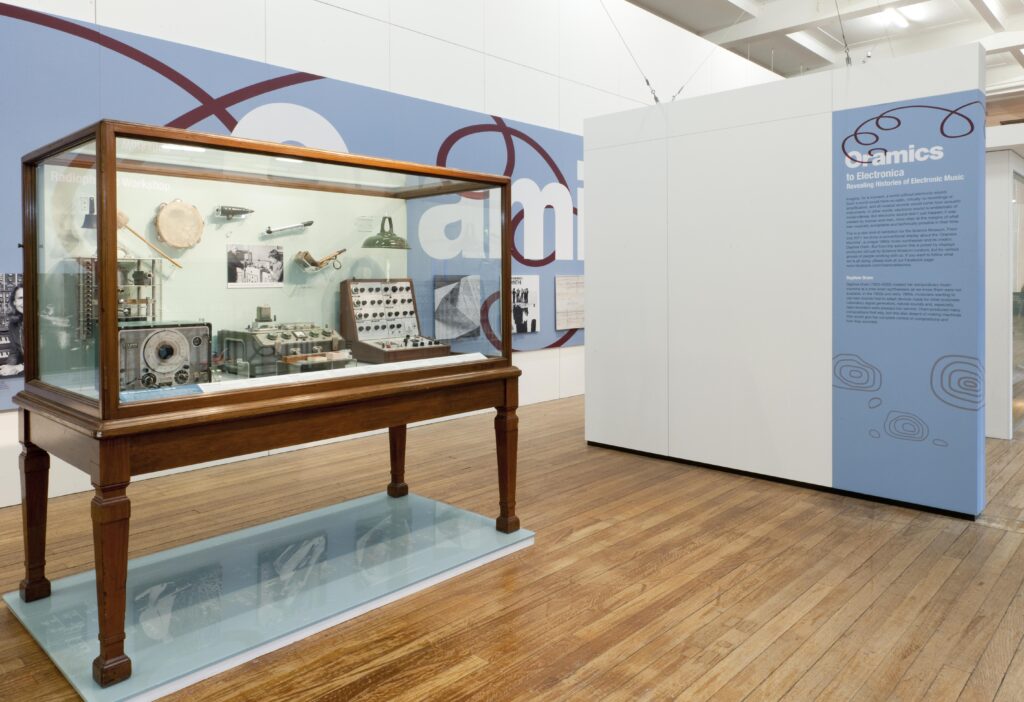
During the 1970s EMS was the site of collaborations with composers including Harrison Birtwistle as well as the development of music programming languages and research into speech synthesis. At the same time, the company, EMS London Ltd, designed and manufactured instruments and other audio devices, running a small factory in Dorset and a shop in London. Zinovieff and his colleagues intended that the manufacturing operation would pay for the creative and research work of the studio. However, this model proved hard to sustain and in 1979 EMS went into receivership, its manufacturing operation was sold off, and the studio, which had by then moved to Oxfordshire, closed. Yet during EMS’s decade of activity, important contributions were made to electronic music research, composition and hardware and software design, as well as more generally to the culture of electronic music in the UK and Europe through the distribution and sale of its synthesizers.[1]
In 1970, having launched the VCS3, the founders of EMS London Ltd were considering building a larger and more complex synthesizer. The prototype for a VCS4 was built, comprising two VCS3s and a keyboard interface (Cox, 2021). This instrument never went into production. Instead, a commission from Radio Belgrade in the former Yugoslavia provided the impetus to develop what became known as the Synthi 100. Paul Pignon, an English musician and composer based in Belgrade, was working with the composer Vladan Radovanović to set up a new electronic music studio at Radio Belgrade and, being aware of the VCS3, discussed with Peter Zinovieff and David Cockerell the possibility of making a larger synthesizer along the same principles, specifically for the broadcaster’s new studio.
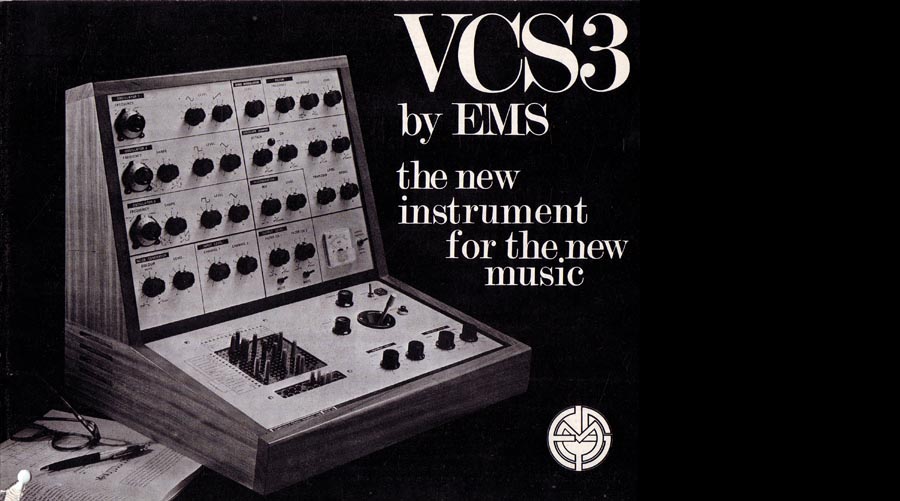
As EMS developed the specifications for Radio Belgrade’s new synthesizer (briefly known as the Digitana), Zinovieff suggested an identical model to the BBC Radiophonic Workshop, whose director was looking to invest in the new voltage-controlled synthesizers then becoming available from companies such as Moog (Niebur, 2010). The first Synthi 100, named the ‘Delaware’ after the studio’s location on Delaware Road, was thus installed at the BBC in April 1971. As the Belgrade model was in production, two more were manufactured, one going to Cardiff University and the other kept at EMS in London. Radio Belgrade’s synthesizer was no longer a one-off project, but the fourth in a run of 31 synthesizers installed in a number of international electronic music institutions including Studio for Electronic Music at West German Radio in Cologne (where it was notably used by Karlheinz Stockhausen).[2]
EMS marketed the new invention to those seeking to make ‘really exacting composition and realization work in professional and electronic music studios, broadcasting companies and universities’, as a brochure put it (EMS, c.1972). Rather than describing it as an instrument, the Synthi 100’s makers referred to it in documents such as these as a ‘professional music studio’, rather like the way in which the digital audio workstation (DAW) is envisaged today. If the VCS3 (its initials standing for ‘voltage-controlled studio’) had also aimed to represent a studio in miniature, it was nonetheless a portable, playable instrument that could adapt to a number of environments; in contrast, the Synthi 100 was an environment in itself. Its sheer size – around six feet long and five feet high, with a depth of over three feet – meant that it could not help but be the central feature in any studio in which it was installed; its technical specifications, described below, also indicate that it may have been intended to provide users with a kind of EMS in microcosm, reflecting the preoccupations with sonic complexity, digital control of musical material, and the potential for generative composition that also animated the research and composition being done in Peter Zinovieff’s studio.
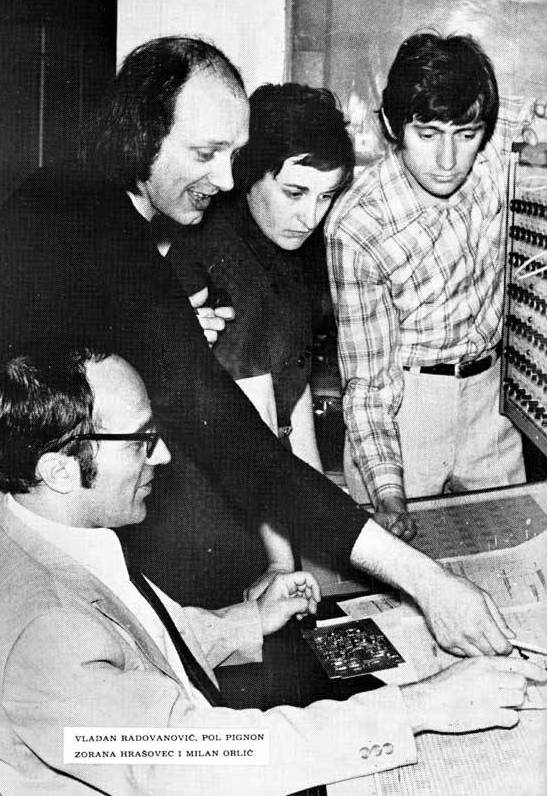
The Synthi 100 expanded on the basic model of the VCS3 with 12 oscillators to the VCS3’s three, and three envelope shapers, noise generators, voltage-controlled filters and ring modulators to the VCS3’s one, and so on. Rather than the ‘post office’ style patchbay and cables seen on contemporaneous synthesizers such as those built by Moog, the VCS3 allowed the user to connect and control its modules by placing pins into a 16 x 16 matrix (see Figure 4). On the Synthi 100, this became two larger, separate matrices, one for input signals and one for voltage control. A 256-step digital sequencer was included, with two five-octave keyboards acting as an interface through which the composer could record a sequence of control voltages to the sequencer’s digital memory. The sequencer – a unique addition to any synthesizer at this time – brought together analogue and digital technologies, reflecting the ‘hybrid synthesis’ techniques that had been developed at EMS, in which computers were programmed to control analogue sound-making devices (Manning, 2013). The sequencer was subsequently manufactured and sold as a separate device (the Sequencer 256) by EMS.
With a starting price of around £6,500 in 1971 (the equivalent of around £84,000 in 2022), the Synthi 100 was unlikely to be sold to private individuals without a large institutional budget. This meant that the fortunes of the Synthi 100 were, to some extent, tied to the fortunes of electronic music institutions, which fluctuated along with changes in funding, institutional priorities, new developments in music technology, and other factors. The BBC Radiophonic Workshop, for example, made radical changes to its studios in the early 1980s, re-equipping the Workshop with new digital equipment, and in 1984 its ‘Delaware’ Synthi 100 was dismantled so that the sequencer could be sold separately to another studio (Niebur, 2010; Briscoe and Curtis-Bramwell, 1983; Brian Hodgson, interview with author, 2016). During the 1980s and 90s, other Synthi 100s faced similar fates. In 1983, the Director of the University of East Anglia’s Electroacoustic Studio, Denis Smalley, putting together an internal funding bid to buy new equipment, wrote:
Ten years ago the Synthi 100 was regarded as a technological highpoint, but now because of the developments in digital technology which have initiated radical musical change, it is an inadequate museum piece (Smalley quoted in Waters, 2008).
As to its worth as an investment, Smalley noted that, unfortunately, the synthesizer ‘has no significant resale value because of its obsolescence’ (ibid).
Forty years later, as the projects described in this article demonstrate, the Synthi 100 is no longer viewed as obsolete, but as a valuable object that illustrates the innovative nature of early electronic musical instrument design. It can also come to represent an institution’s history, becoming part of events marking important anniversaries or, in the case of Radio Belgrade, to relaunch its Electronic Studio. Here, the Synthi 100 takes on a new status as an institutional heritage object, representative of particular musical-historical spaces as well as an artefact that more generally symbolises an important period of electronic music history. It presents an opportunity to study not only the instrument itself but also the histories and cultures it is called upon to represent, such as that of the institutional experimental electronic music studio established between the 1950s and 1970s.
One of the important ways in which the Synthi 100 can animate, rather then merely represent historical narratives of electronic music is through its recent use in the composition of new music that does not explicitly seek to recreate or imitate that of the past. The Synthi 100 may be presented as emblematic of an institution’s history, but this presentation works in tandem with a drive to re-establish it as a working instrument that can be used as part of a contemporary composition or sound art practice. The decision to approach the restoration and public presentation of an historical electronic musical instrument in this way is taken for a number of overlapping financial, practical, scholarly, aesthetic and institutional reasons, some of which I attempt to outline in this article, with the aim of situating the production and presentation of new compositions on an instrument such as the Synthi 100 as important aspects of the process of its restoration, not just the results of it. Star and Griesemer‘s (1989) notion of the boundary object provides a model for thinking about changes in the use, status and public perception of a restored electronic music instrument – through which, or even because of which, the production of new works might become desirable – as well as focusing attention on the networks of knowledge and practice that help to effect those changes.
The Synthi 100 as a boundary object in Melbourne, Ghent, Belgrade and Athens
Star and Griesemer’s boundary object is one that can ‘inhabit several intersecting social worlds…and satisfy the informational requirements of each of them’ (Star and Griesemer, 1989, p 393). The term ‘object’ refers not only to physical objects but also ensembles and assemblages of objects, and even concepts and bodies of knowledge that connect various groups of people but can be experienced, understood and used differently by them. It is a framework that lends itself to research into histories of electronic music studios and instruments, as seen in Pinch and Trocco’s study of the Moog synthesizer, Analog Days. In this text, Robert Moog and other figures in the development of the first synthesizers are described as ‘boundary shifters’ – those whose professional and creative identities shift between the worlds of music, engineering and commerce, and in doing so, ‘produce a transformation’ in each of those worlds (Pinch and Trocco, 2002, p 314). Bowker and Star’s formulation of the ‘marginal figure’ (1999, p 303), explored later in this article, describes a similar dynamic.
The reconstruction and new use of ‘obsolete’ music technologies such as analogue synthesizers prompt new boundary spaces to emerge which both the material object in question and indeed the concept of ‘the electronic musical instrument’ can inhabit at different points in time as well as among different social worlds and communities. A reconstructed or restored device exemplifies Star’s later assertion that the boundary object’s use and properties can change through renewed use by different groupings of people, even if these groups maintain some constant members – for example, an engineer who was originally responsible for a synthesizer’s maintenance in the 1970s and also takes part in a present-day restoration project. The restored instrument is not only perceived differently by its new users, but actually made differently by and for them (Star, 2010, p 613). In the process of restoration, changes are made to both its material properties and its cultural and social identity. While it may still be known as ‘a Synthi 100’, this term has different meaning and value when used by, for example, a collector of ‘vintage’ electronic instruments, a technician running a repairs company, the programmer of an arts event at a museum, a researcher or a young composer or musician encountering the synthesizer for the first time. Considered as a boundary object, it can effect and has effected numerous ‘translations’, being meaningful, dynamic, obsolete, and then refigured with different meanings, by different social worlds, and in different historical eras. In order for these processes to take place, networks are formed among and between the various participants in restoration projects, as well as within, or with an awareness of, wider communities of electronic music practice and listenership, who are likely to be engaged at the point of live performance.
The Synthi 100 restoration projects described in this article have taken place through and across intergenerational, interdisciplinary, cross-institutional and sometimes international networks of individuals and organisations. These networks are key to the dynamic of translation and transformation described above. Below, I provide brief descriptions of Synthi 100 restoration projects carried out at the Institute for Psychoacoustics and Electronic Music (IPEM) in Ghent and the University of Melbourne that illustrate the importance of localised networks, before outlining in more detail the local and international networks of practice and knowledge that informed similar projects in Belgrade and Athens, as a precursor to considering the importance of live performance to these latter two projects in particular.
Melbourne and Ghent: local knowledge networks
Some knowledge networks of restoration projects bring to light narratives of continuity within and commitment to a particular musical environment. In 2015 at the University of Melbourne, a Synthi 100 was restored by Leslie Craythorn, the chief technical officer of the University’s music school, who had worked with the instrument from when it first arrived in Melbourne in 1973. In 2016, Craythorn was given a prestigious Engineering Heritage Marker award for his restoration work and has supported composers and Melbourne University students wanting to make new music on the Synthi (Brown, 2016). In May 2018, a concert of new works for the Synthi 100 by composers Anthony Lyons, Mark Pollard and David Haberfeld, of the University’s Interactive Composition programme, was live-streamed from the Melbourne Conservatorium of Music, where the Synthi 100 is housed (Parade, 2018). The concert coincided with Synthesizers: Sounds of the Future, an exhibition at the University’s Grainger Museum, which, as the Grainger Centre, had been an important location for electronic music in Melbourne in the 1960s and 70s (University of Melbourne, 2018).
To give another example, the Synthi 100 at the Institute for Psychoacoustic and Electronic Music (IPEM, established in 1962) in Ghent was restored and has been used in public-facing projects since 2017 due mainly to the efforts of Ivan Schepers, a technician who had worked there since 1979, when the Synthi 100 – the last to be built by EMS – was acquired. At various points Schepers had fought to prevent it from being sold by the University, either to a museum or a private collector; his wish was to see it working again and used by students and composers (interview with author, 2016). For this to happen, there needed to be support from a wider, and multi-generational, network of practitioners. From 2012, a slow process of fixing and restoring the Synthi 100 was underway, carried out by a Brussels-based engineer, Constantin Papageorgiadis, who, according to Schepers, had done much of the work for free. Its cause was further taken up by local musicians, the dance music producers David and Stephen Dewaele, known as Soulwax, synthesizer enthusiasts for whom Papageorgiadis had done repair jobs. In 2017, the now working Synthi 100 was displayed at De Krook, a new science and art centre at the University of Ghent. It was used with new interfaces developed at IPEM, which controlled the playing of a composition by Soulwax. Thus, the instrument became enfolded into the institution’s current research concerns of music cognition and embodiment, as well as being used in a popular music context which had the potential to engage new audiences (Maes et al, 2017).
Athens and Belgrade: international communities of practice
The restoration of the Synthi 100 in Belgrade was initiated in 2016 by the Radio Belgrade 3 producers Ksenija Stevanović and Irena Neimarević, both of whom are also musicologists. The aim was to restore the Synthi 100 to working order as part of a wider initiative to relaunch the Electronic Studio, which had been used only sporadically since the early 2000s (Milojković, 2017), at the same time as researching and publicising its history. As well as the concert described in this article, there have been artistic residencies, radio broadcasts and other events centred on the Electronic Studio and the Synthi 100.
Artist and composer Svetlana Maraš was invited to run the relaunch project, on which she collaborated with two engineers, Jari Suominen and Daniel Araya, as well as with Paul Pignon, the co-founder of the studio who originally commissioned the Synthi 100 to be built and was heavily involved in its design and early use. As a Serbian composer based in Belgrade, Maraš knew about the Synthi 100 through local networks of artists and musicians, and was cognisant of various stories and myths that had built up around this instrument that, while no longer working, was still in the same room of the radio station in which it had been installed in 1971. It was essential for her that the initial aim of the project should be to make the Synthi 100 operational again, as she regarded it as, ‘the focus, the central part of the studio’ (interview with author, 2018). When asked his advice about beginning the restoration, Pignon suggested the engineers, Suominen and Araya; by coincidence, Suominen and Maraš knew one another from the Media Lab at Aalto University, Helsinki, where both had studied.
At the time of this project, Daniel Araya was the studio engineer at Stockholm’s Elektronmusikstudion (also known as EMS: in this section I refer to it as EMS Stockholm to avoid confusion with the London-based EMS), an institution with which Pignon, who has lived in Sweden since the 1980s, has worked frequently. A proportion of Araya’s work involves the maintenance and mending of synthesizers from the 1970s, such as EMS Stockholm’s Buchla and Serge systems; he is also a builder of his own musical devices and a producer of electronic dance music (Morgan, 2015). Jari Suominen, an artist and researcher based in Helsinki, was part of an extensive project to research and rebuild the instruments of Erkki Kurenniemi, the Finnish composer and inventor whose research into digital control of sound in the 1960s and 70s paralleled some of the projects being developed at EMS in London at the same time (Suominen, 2013). Suominen’s DIMI Is Reborn project saw him building a replica – what synthesizer builders usually call a ‘clone’ – of the DIMI-A, and as part of that project he undertook a residency at EMS Stockholm, connecting him with Araya and Pignon (EMS Stockholm, 2016).
Pignon recommended Araya and Suominen to Radio Belgrade not only because he knew them through EMS Stockholm but also because Araya and Suominen had recently completed another Synthi 100 restoration for the Contemporary Music Research Centre (KSYME-CMRC) in Athens. In a similar manner to Belgrade, this restoration project was instigated by a prolific local musician, the composer and sound artist Marinos Koutsomichalis. The project was supported institutionally by both KSYME-CMRC and Documenta, the international contemporary art festival. Collaborating with EMS Stockholm, Documenta14 commissioned new works for Synthi 100 by Greek and Swedish composers (Marinos Koutsomichalis, Panos Alexiadis, Lisa Stenberg and Jonas Broberg) to be performed at events in Athens in April 2017 at which the histories of KSYME-CMRC and the Swedish arts organisation Fylkingen were compared and discussed.
Practitioners such as Araya and Suominen – and indeed Maraš and Koutsomichalis – who may be affiliated with public arts and academic institutions, but are or have also been involved in cultures and subcultures of electronic music and media arts, develop their skills not only through academic and professional training but also through individual experimentation and via networks of independent commercial engineers, artists, and bodies such as small record labels, hackspaces, music venues and so on. Through the various activities that these practitioners undertake, which can be gathered under a general heading of electronic ‘musicking’ (Small, 1998), various ‘communities of practice’ (cf. Bowker and Star, 1999, p 295)[3] form, overlap and communicate with one another around an idea of historic electronic music technology in which composition and performance emerge as important factors.
A link can be made here with the ‘marginal’ figure identified by Bowker and Star (1999), who, I argue, appears frequently in accounts of the development of the post-war electronic music studio. In the case of EMS and the Synthi 100, we might think of people such as Paul Pignon and the BBC Radiophonic Workshop’s Brian Hodgson, the studio manager who pressed for the Radiophonic Workshop’s acquisition of a Synthi 100 in 1971 (Niebur, 2010). The term refers to people who are members of more than one community of practice and who are thus able to ‘naturalize the same object differently’ (Bowker and Star, 1999, p 303), in this case, a new and complex technological object. Through the marginal figure, a number of different interest groups, from creative to bureaucratic, are able to form a relationship with or at least gain enough understanding of the object to support its use, even if they do not use it themselves.
These figures’ ability to move between different social, cultural, institutional and scientific-technological registers contributed to the formation of electronic music studio cultures in the 1960s and 70s, when studios such as the ones mentioned in this article were being set up. The marginal figure of the present day similarly moves between various registers, establishing their membership of different electronic music communities in part through what Bowker and Star describe as ‘the experience of encountering objects and increasingly being in a naturalized relationship with them’ (Bowker and Star, 1999, p 295), which is then shared with and reinforced by others. Like their forbears, this marginal figure also co-creates cultures of electronic music, which are now located not only in studios and workshops but also live music spaces, art institutions and museums, as well as numerous online environments.
It is interesting to note that the marginal figure of older engineer or studio technician is often an important participant in these contemporary projects, acting as an adviser to if not the actual instigator of the work. As well as the important roles of Leslie Craythorn, Ivan Schepers and Paul Pignon in their various projects, Robin Wood, who worked at EMS as an engineer in the 1970s and still builds and repairs VCS3s, has been a point of contact for many of the Synthi 100 restoration projects, providing manuals, historical information and replacement parts. An increasing number of scholars, including Williams (2016), Zattra (2017) and others, have challenged dominant narratives about electronic music and sound that focus primarily on composers and well-known inventors such as Robert Moog. Star’s concepts of the boundary object and the marginal figure offer a further challenge to such narratives, not only reminding us of the collaborative aspects of electronic music-making but also providing a theoretical framework within which the roles of less well-known figures in the formation and proliferation of electronic music cultures can be asserted.
As the Synthi 100 was an object around which a community of knowledge and practice formed in institutions like Radio Belgrade in the early 1970s, we can see from these brief accounts how, in the present day, the same instrument takes on a similar role in new networks and communities that likewise draw knowledge and expertise from various institutional, technological and artistic milieus. We might also say that an international network has formed that is focused specifically on the restoration and re-presentation of various models of this one particular device.
In the following section I describe an approach to electronic musical instrument restoration that is characteristic of this community of practice, which has as its goal an operational instrument that can be used to compose new musical works.
Operative media and the importance of maintenance
In his writing on the conservation of historical computers, Swade (2011) outlines the various terms that, while often interchangeable in everyday speech, indicate differences in the extents, aims and outcomes of projects that re-make, in various ways, an historical technological device. In Swade’s assessment, a restoration – which is the word I have generally been using – returns an existing object to its original state, possibly but not always in working order. A replication or replica is the act of making a copy with an existing object for reference. A reproduction is also, in many senses, a copy. The difference here seems to be one of purpose and context: a reproduction is primarily for display, whereas a replica’s purpose is more functional. For example, a replica could give an insight into the working processes of an historical object to a researcher who cannot work with the original device because it is too fragile. A reconstruction can have a similar research objective, but in this case, unlike the replica, an object is recreated without an ‘intact surviving example’ (Swade, 2011, p 107), such as a musical instrument reconstructed from a few surviving elements. Finally, Swade lists simulation – the virtual or ‘logical’ replication of an object. This is of particular relevance to researchers into electronic music histories as many analogue synthesizers, including the EMS VCS3, are now produced in virtual versions as ‘soft synths’.
Many projects of re-making are likely to fall into more than one category, if not at the same time, at different stages of the work. Within those categories, too, are variations and nuances that depend on the priorities of a project – for example, a reconstructed device might look quite different if it is aiming for ‘operational rather than visual realism’ (ibid.). However, the existence of these categories can prompt us to consider a number of important questions about the aim and purpose of a project. We can ask whether it is essential that all parts of a machine be original, or whether some can be newer equivalents – an example might be the type of wiring or the potentiometers in a synthesizer. Restorers may choose to create a new, updated version of a no longer working device in order to make it easier to use, or owing to the rarity, cost or unavailability of the original components.
It is here that the consideration of whether the instrument is to be used in live performance may come into play. For example, in correspondence with the author, Jari Suominen has described how, when working on the Athens Synthi 100, he replaced the no longer working sequencer with a replica, replacing 13 of the missing PCBs with a single board using AVR technology. One practical reason for this was that it would have been beyond the project’s budget to restore the sequencer to the original conditions of its production; but this fact alone tells us about the aims and priorities of the project more generally, in which maintenance and repair emerge as key terms alongside those referring to restoration, reconstruction, and so on. For the purposes of this argument, we will assume the original sequencer had worked[4] – and, had it been well maintained, as it was in the Belgrade Synthi 100, would have been updated and fixed over the years. With this in mind, we can see how it was less important for Suominen to rebuild it with original parts than it was for him to return it to a state in which a musician’s experience of playing the instrument interface would be similar to what it would have been like at any point between 1975, when it was acquired, and whenever the Synthi 100 stopped working. Additionally, Suominen added MIDI (Musical Instrument Digital Interface) capability to the sequencer, thus making an update to the instrument that would allow the Synthi to be used with other digital devices. Had the aim of the project been to replicate the conditions of the Synthi 100’s original assembly, the sourcing of original parts, or replicas of parts that would have been available in the early 1970s, would have been imperative, and no additions would have been made.
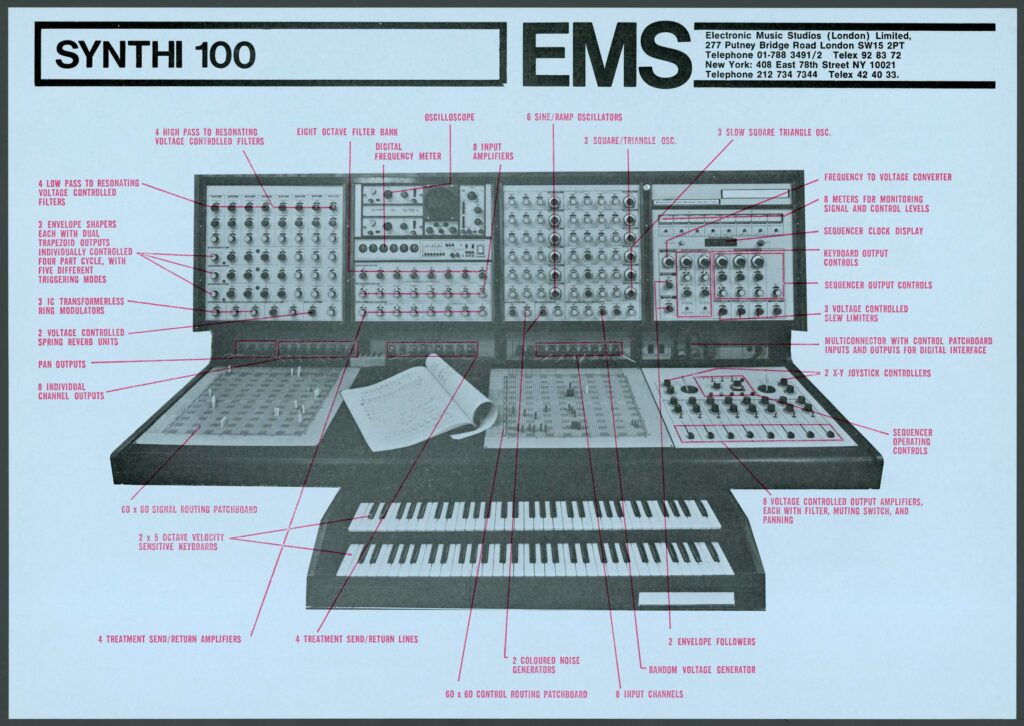
Similarly, in an interview with Svetlana Maraš about the Belgrade Synthi 100, Daniel Araya states:
We service instruments that are going to be used and not just sit in a collection and we do it for institutions that have limited budgets. We try to stay true to the original nature of the instrument, but some of the parts used were terrible, really, and did not stand either the test of time or the test of musicians! So we try to keep a middle ground, we are not scouring the Internet for identical potentiometers, we get better quality ones instead and we change out bad types of switches for modern models even if they look slightly different from the originals. To do a museum-quality restoration would take enormous amounts of time and money and it would probably not hold up for day-to-day use (Maraš, 2019).
Araya and Suominen’s focus on maintenance and operational performance challenges the idea that there is an ideal original state to which a Synthi 100 should, or even can be returned. It can be viewed instead as an instrument with an ongoing operational existence that, while it has not been used for some time, has already undergone various repairs, modifications and alterations, and can therefore accommodate more. While this is a practical view, influenced by time and budgetary constraints, it is also a conceptually rich one. Jackson (2014, p 222), drawing on Star and Strauss’s (1999) writing on ‘articulation work’, positions repair as ‘subtle acts of care by which order and meaning in complex sociotechnical systems are maintained’. The networks of people and technologies described in previous sections can be thought of as constituting such systems; so too can electronic music communities, and indeed other musical communities more generally. Jackson’s formulation of repair as ‘timely’ work that ‘bridges past and future’ has particular relevance for communities or networks based around an interest in and use of historic music technologies.
The forefronting of repair and maintenance also resonates with writings in media archaeology that prioritise operationality through the idea that media is in itself uniquely and constantly operational. We might consider Ernst’s notion that, although we might access the ‘thinking and working time of the past’ in an historic ‘chronopoetic’, which is to say ‘time-creating’ device such as a synthesizer, it becomes ‘ahistorically operative’ when restored and used again in the present day (Ernst, 2016, p 212). Suominen and Araya’s practical conceptualisation of the Synthi 100 as a device to be maintained throughout a long operational life span is a useful materialisation of such theories, as are the composition and performance-based projects that their restorations make possible.
In the following sections I describe two examples of concert programmes featuring Synthi 100s restored by Araya and Suominen. I consider how the Synthi 100 is shown and understood to be not only an historic instrument but also a functioning, operative device upon which live music can be played; I also consider how that impression is conveyed to audiences via the style and context of performance. In doing so, I will ask what these live performances might tell us about the history of the Synthi 100 and the institutions it is housed in; and about current preoccupations in electronic music.
The Synthi 100 in performance
Radio Concert No.1: past and present cultures of live electronic music
Link to music and video: https://www.svetlanamaras.com/radioconcerts.html
In March 2018, a performance celebrating the re-opening of the Electronic Studio at Radio Belgrade was filmed for the Concerts In Studio 6 series, a live music programme in which concerts are watched by a studio audience and simultaneously broadcast on Radio Belgrade 3 and the digital TV channel RTS3. The concert was posted on YouTube, where it has gained almost 5,000 views at the time of writing. While the objective of the concert was, in part, to celebrate the Electronic Studio’s history, the main focus was on the performance of new music, rather than the playing of recorded works from its early and most active period in the early- to mid-1970s. New works by Svetlana Maraš, Paul Pignon and the Italian musician Nicola Ratti were performed by their composers in two spaces within the RTS building: Studio 6, a space set up for live concerts with an audience, and the Electronic Studio itself – on a different floor of the building – where Maraš performed a piece for Synthi 100 called Radio Concert No.1, which I will focus on in this section.[5] Her performance was filmed and screened live for the audience in Studio 6.
The new compositions utilised the Synthi 100 in different ways. Pignon played an amplified bass clarinet, triggering patches on the Synthi 100 via its frequency-to-voltage convertor; the Synthi then re-processed the clarinet’s sounds, with which Pignon interacted. Ratti performed his composition on a modular synthesizer, incorporating some pre-recorded sounds from the Synthi 100 into his performance via a laptop. Maraš’s Radio Concert No.1 presented the Synthi 100 most explicitly as an instrument to be used in live performance. However, it is notable that the performance itself took place under conditions that did adhere to conventional concert conditions. The Electronic Studio was brightly lit from overhead lights, in contrast to the atmospheric stage lighting used for the other two performances; and Maraš was in a different room than her audience, who could see her only via a screen. This setting, therefore, also referenced the Synthi 100’s history as a studio-based – and indeed, a studio-bound – device, by situating the performance in the Electronic Studio itself, filming it and presenting it to the audience in the TV studio.
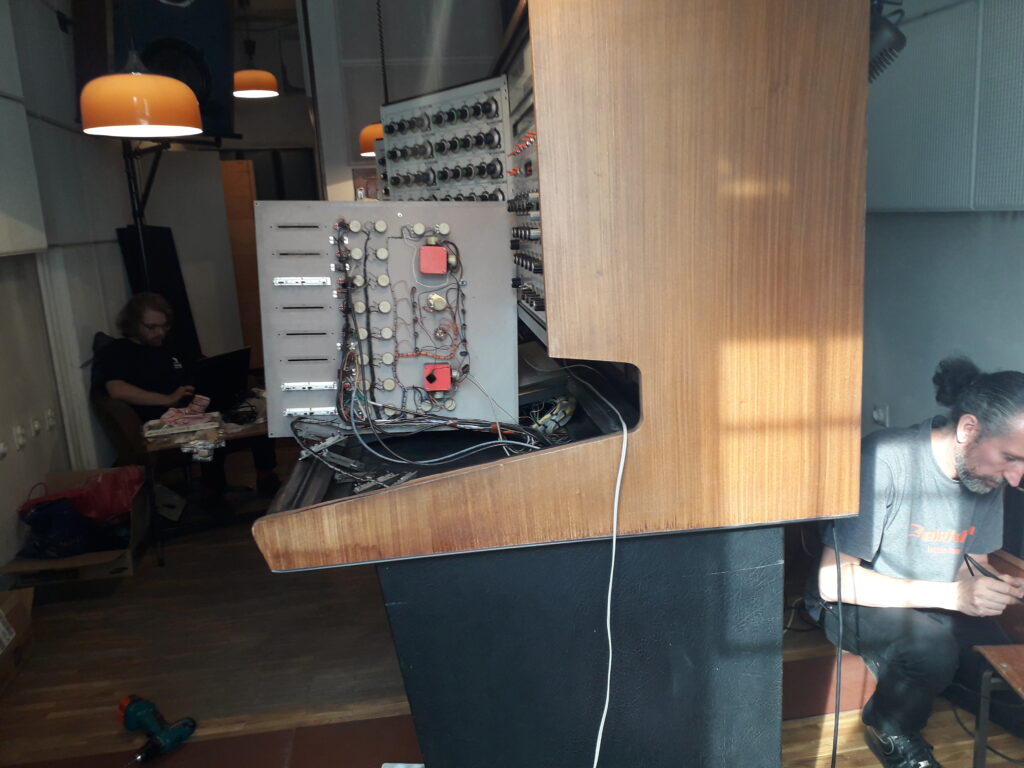
In Maraš’s own words, Radio Concert No.1, in which she used the Synthi 100 and a tablet running PureData and Ableton Live and the TouchOSC interface, creates ‘improvisational dialogues’ between Synthi and computer (Maraš, n.d.). An additional aim of the work was to explore some of the similarities between Maraš’s own, primarily digital working methods and that made possible by the Synthi 100, formulating a relationship between technologies and practices from different eras.
Watching the filmed performance, it is possible to see and hear how Maraš explores the gestural possibilities of the synthesizer and the tablet, manipulating the synthesizer’s joystick, dials, sliders, trapezoids, and their digital equivalents on the touchpad, creating ‘a dynamic interactive interface on the tablet and tweaking the Synthi sounds live and playing with their parameters’ (interview with author, 2018). A handheld camera moves with Maraš, focusing closely on her hands as she manipulates the touchpad of the tablet and the controls of the Synthi, and then moving upwards to her face, which is seen in close-up and in profile. This is edited with shots from above and behind, in which the Synthi’s size appears particularly striking.
The performance as a whole responds to those demands for televisual ‘proximity and intimacy’ that the performance theorist Philip Auslander, drawing on Walter Benjamin, isolates as having influenced live performance from the mid- to late-twentieth century onwards (Auslander, 2008, p 184; see also Benjamin, 1973 [1935]). Alongside filmed performance for broadcast television, there is now an online visual culture of electronic music making on platforms such as YouTube and Instagram that, while influenced by televisual conventions, demands an even greater proximity and intimacy by showing not only the performance but also the composition of music, often in a musician’s private space rather than a concert venue: we might think of the ‘Against The Clock’ videos produced by Fact magazine, in which musicians, usually filmed in their home studios, are given ten minutes to create a track. The filming of Maraš’s performance highlights the studio’s status as a workspace and her role as a composer-performer. This not only demonstrates Maraš’s skill and creativity, but also translates the Synthi 100 into a register familiar to online visual cultures of electronic music in which listeners – who are often also musicians and/or makers – are used to looking closely at music technologies while listening to music, and sharing, commenting on and otherwise interacting with audiovisual content. In this way, a performance of an electronic composition for official broadcast on a national TV station can engage an audience outside of its immediate cultural and geographical context, not only through its presence on YouTube but also through its use of an audiovisual grammar recognisable to a wider electronic music audience.
The focus on new, live electronic music on Concerts In Studio 6 was not just due to considerations of what might be more appealing for audiences to watch – although this was clearly important – but also alludes to an aspect of the Synthi 100’s historical use. During the 1970s, Paul Pignon frequently used the Synthi 100 as a processor of acoustic instruments such as the clarinet and saxophone; additionally, his experiments with the Synthi 100 creating what he has described as ‘musical automata’ can be seen as congruent with an idea of live electronic music in which the electronic device is a responsive, possibly unpredictable co-performer (Pignon, 2019). We might say, then, that electronic music that demonstrably explores the interaction of human and machine has always had a presence in the Radio Belgrade Electronic Studio, and therefore the concert redresses an historical imbalance by bringing this strand of the Studio’s work, which has historically been less documented through recordings and broadcasts, to the forefront.
Metaichmiakó: material properties and historical absences
Link to music:
https://marinoskoutsomichalis.com/projects/metaichmiako/
https://vimeo.com/240683239?embedded=true&source=video_title&owner=10260873
As described earlier, the restoration of the Synthi 100 in Belgrade took place almost contemporaneously with a similar project in Athens, instigated by Marinos Koutsomichalis and situated within an initiative to commemorate the history of the Contemporary Music Research Centre (KSYME-CMRC) and explore the history of electronic music in Greece. In April 1917, two concerts featuring performances of new compositions on the restored Synthi 100 were hosted by Documenta 14 at Megaron Mousikis, a large concert venue.

Like Svetlana Maraš, Koutsomichalis’s interest lies primarily in how the distinctive qualities and functions of the Synthi 100 can be explored through current electronic music practice, rather than seeking to perform historically faithful versions of older compositions. However, for his performance of his composition Metaichmiakó he did not use any digital devices alongside the Synthi 100. Significantly, he chose to use the Synthi’s keyboard-controlled sequencer, which one would expect to be one of the least amenable parts of the instrument for live performance, to set up semi-melodic sequences using unusual timbres that affect the oscillators and in turn generate a feedback network across the synthesizer. Because Koutsomichalis’s approach to the Synthi 100 is based in part on an interest in its material properties, he was fascinated by what he describes as the sequencer’s ‘problems’. Referring to the experimental period of instrument design at which the Synthi 100 was invented, he states, ‘I wanted to make it part of the performance, because I consider that a really important part of the character of the synthesizer… I wanted to work on these notes exactly because they weren’t stable’ (interview with author, 2018).
In this instance, then, a live performance becomes a means through which the material properties of the Synthi 100 can be explored, and aspects that could be thought of as deficiencies or flaws become affordances for unusual and interesting sonic and musical structures. A prevalent interest in the material qualities of sound in composition and sound-based art, which Demers (2010) relates to visual art discourses of materialism, means that instruments or devices, rather than merely being the means to realise a musical idea, themselves became the aesthetic basis of a work: this approach is articulated clearly in Koutsomichalis’s performance of Metaichmiakó, with its emphasis on the material qualities of the instrument. From this perspective, a live performance using an historical electronic instrument is of interest precisely because the instrument has sonic and material properties that are unusual and unpredictable. Its placement within a contemporary visual art festival underscores the increasingly blurred disciplinary boundaries between electronic music and sound art practice (cf. Gardner and Voeglin, 2016).[6]
During Documenta, the restored Synthi 100 and framed scores and schematics were displayed at KSYME-CMRC (Documenta, 2017), in a clear indication of the synthesizer’s importance to the institution’s history. However, the historical narrative that the Synthi 100 illuminates is not unequivocally celebratory. The early history of the Synthi 100 in Athens differs from that of the Belgrade Electronic Studio, where the Synthi 100 was used extensively and for many years in a number of significant works. The Athens Synthi 100 was bought in 1975 by the Hellenic Contemporary Music Association, a predecessor to KSYME-CMRC which hosted festivals and concerts and also ran an open studio at which the Synthi 100 was housed (Emmerson, 1977). Yet according to Koutsomichalis it was used only sporadically by local composers, who would mainly utilise it as a source of unusual sounds rather than as a tool for making entire compositions. Eventually it was put in storage and left to fall into disrepair. Koutsomichalis states:
This instrument is around since the 70s in Greece, but you never encounter anyone from the old composers who actually had worked with it. They’ll say, “I remember it was working, and I found a few tapes with recordings from it,” but they mostly used it as a sound generator… If you think about it, for 15 years or more, the instrument was installed in Greece in an era where many things were happening to Greece, cultural-wise anyway, and still I’m not aware of a single composition for Synthi 100, just composers using sounds every now and then. And then we fix it and we do this concert and you have two new works by Greek composers [Koutsomichalis and Panos Alexiadis], with an instrument that’s been in the country for 50 years (interview with author, 2018).
Therefore, the Synthi’s restoration and the concert – in Koutsomichalis’s view – makes a statement about the relationship between electronic music’s past and present in Athens that confronts historical absences and missed opportunities as well as celebrating past achievements; and, rather than chiefly looking back at a fertile period of innovation in electronic music, makes a case for how active the city’s electronic music community is in the present day.
Conclusion
Through the restoration of the Synthi 100 at various institutions, a studio composition tool which was for many years seen as obsolete has been re-presented as a live performance instrument. In this chapter I have outlined some of the networks of practitioners who were involved in these restoration projects, and described the restored Synthi 100’s appearance as a performance instrument on the Serbian television programme Concerts In Studio 6 and at a concert hosted by Documenta14 in Athens. Through these performances, the Synthi 100 becomes translatable to contexts beyond its origins as a studio-based device for the composition of electronic music. Through these projects, the Synthi 100 is situated in different social and cultural worlds, such as that of electronic music practitioners and listeners who often experience music through watching filmed performances online; and that of contemporary art audiences versed in discourses around materialism, conceptual art and sound art.
These projects illustrate the Synthi 100’s trajectory from an obsolete device to its current status as both a heritage object and a versatile, working instrument. They demonstrate how electronic music histories can be constructed and disseminated through practices of making, building, repairing and restoring; and through complementary practices of composition and performance. It is hoped that ethnographic research concerning cultures of electronic music restoration – that is, the individuals, groups and institutions involved in the maintenance and preservation of electronic music technologies – will follow and complement this study, as well as further analysis from media-theoretical and philosophical viewpoints exploring the practice of composition of new music on historic electronic instruments which can add to, and extend beyond, Pinch and Reinecke’s formulation of ‘technostalgia’ (2009).
These projects of restoration and performance can offer insights into how historical electronic instruments figure in current practices of electronic music, and how current discourses of electronic music affect how historical electronic musical instruments are treated and viewed in the present day. Tresch and Dolan (2013) note that, ‘tracing the different projects within which an instrument is deployed over time may illuminate large-scale structural transformations in the aims of musical composition and performance’. To this I would add that tracing such projects may illuminate transformations in other kinds of musical participation, too, from the concerns of those involved in instrument design and repair, to the expectations and experiences of audiences and listeners.
Acknowledgements
Thank you to Svetlana Maraš, Marinos Koutsomichalis, Jari Suominen, Paul Pignon, Ivan Schepers and Anthony Lyons for correspondence, interviews and permission to use images; to this article’s anonymous peer reviewers for their comments and suggestions; and to Kate Steiner and Tim Boon for editorial support. The research from which this paper is devised was originally supported by a Collaborative Doctoral Partnership between AHRC and the Science Museum.
Additional sources:
TV and Radio Broadcasts
Concerts from Studio 6, dir. Nevena Popović, Radio-Television Serbia, March 2018. Available on YouTube: https://www.youtube.com/watch?v=9tUwHGweUxY
Archives
Science Museum Archives, London & Wroughton, UK
– Alan Sutcliffe Archive
MS/2160: Collection of objects and archival material relating to the British company Electronic Music Studios (EMS) (1969–1979)
Interviews
Brian Hodgson, 2016
Ivan Schepers, 2016
Paul Pignon, 2017
Marinos Koutsomichalis, 2018
Svetlana Maraš, 2018



